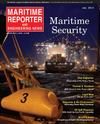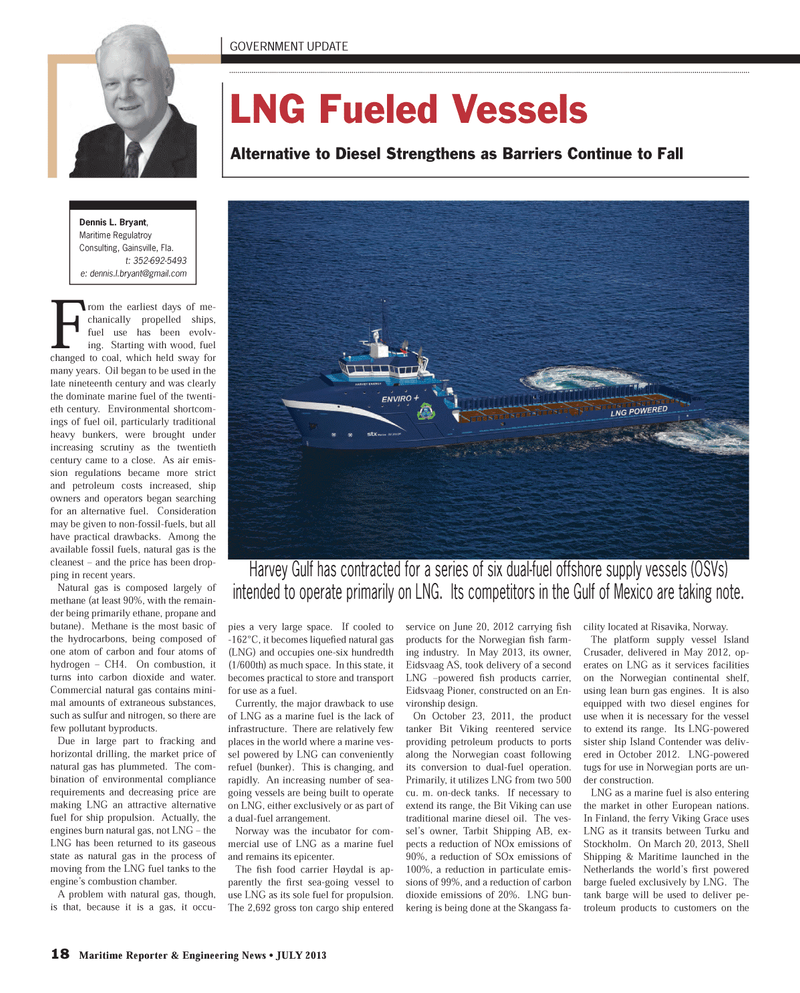
Page 18: of Maritime Reporter Magazine (July 2013)
Maritime Security Edition
Read this page in Pdf, Flash or Html5 edition of July 2013 Maritime Reporter Magazine
18 Maritime Reporter & Engineering News ? JULY 2013 GOVERNMENT UPDATE LNG Fueled Vessels Alternative to Diesel Strengthens as Barriers Continue to Fall From the earliest days of me-chanically propelled ships, fuel use has been evolv-ing. Starting with wood, fuel changed to coal, which held sway for many years. Oil began to be used in the late nineteenth century and was clearly the dominate marine fuel of the twenti-eth century. Environmental shortcom- ings of fuel oil, particularly traditional heavy bunkers, were brought under increasing scrutiny as the twentieth century came to a close. As air emis- sion regulations became more strict and petroleum costs increased, ship owners and operators began searching for an alternative fuel. Consideration may be given to non-fossil-fuels, but all have practical drawbacks. Among the available fossil fuels, natural gas is the cleanest ? and the price has been drop-ping in recent years.Natural gas is composed largely of methane (at least 90%, with the remain-der being primarily ethane, propane and butane). Methane is the most basic of the hydrocarbons, being composed of one atom of carbon and four atoms of hydrogen ? CH4. On combustion, it turns into carbon dioxide and water. Commercial natural gas contains mini-mal amounts of extraneous substances, such as sulfur and nitrogen, so there are few pollutant byproducts. Due in large part to fracking and horizontal drilling, the market price of natural gas has plummeted. The com- bination of environmental compliance requirements and decreasing price are making LNG an attractive alternative fuel for ship propulsion. Actually, the engines burn natural gas, not LNG ? the LNG has been returned to its gaseous state as natural gas in the process of moving from the LNG fuel tanks to the engine?s combustion chamber. A problem with natural gas, though, is that, because it is a gas, it occu-pies a very large space. If cooled to -162°C, it becomes liqueÞ ed natural gas (LNG) and occupies one-six hundredth (1/600th) as much space. In this state, it becomes practical to store and transport for use as a fuel.Currently, the major drawback to use of LNG as a marine fuel is the lack of infrastructure. There are relatively few places in the world where a marine ves-sel powered by LNG can conveniently refuel (bunker). This is changing, and rapidly. An increasing number of sea- going vessels are being built to operate on LNG, either exclusively or as part of a dual-fuel arrangement.Norway was the incubator for com-mercial use of LNG as a marine fuel and remains its epicenter. The Þ sh food carrier Høydal is ap- parently the Þ rst sea-going vessel to use LNG as its sole fuel for propulsion. The 2,692 gross ton cargo ship entered service on June 20, 2012 carrying Þ sh products for the Norwegian Þ sh farm- ing industry. In May 2013, its owner, Eidsvaag AS, took delivery of a second LNG ?powered Þ sh products carrier, Eidsvaag Pioner, constructed on an En- vironship design. On October 23, 2011, the product tanker Bit Viking reentered service providing petroleum products to ports along the Norwegian coast following its conversion to dual-fuel operation. Primarily, it utilizes LNG from two 500 cu. m. on-deck tanks. If necessary to extend its range, the Bit Viking can use traditional marine diesel oil. The ves- sel?s owner, Tarbit Shipping AB, ex- pects a reduction of NOx emissions of 90%, a reduction of SOx emissions of 100%, a reduction in particulate emis-sions of 99%, and a reduction of carbon dioxide emissions of 20%. LNG bun-kering is being done at the Skangass fa-cility located at Risavika, Norway. The platform supply vessel Island Crusader, delivered in May 2012, op- erates on LNG as it services facilities on the Norwegian continental shelf, using lean burn gas engines. It is also equipped with two diesel engines for use when it is necessary for the vessel to extend its range. Its LNG-powered sister ship Island Contender was deliv-ered in October 2012. LNG-powered tugs for use in Norwegian ports are un-der construction. LNG as a marine fuel is also entering the market in other European nations. In Finland, the ferry Viking Grace uses LNG as it transits between Turku and Stockholm. On March 20, 2013, Shell Shipping & Maritime launched in the Netherlands the world?s Þ rst powered barge fueled exclusively by LNG. The tank barge will be used to deliver pe- troleum products to customers on the Dennis L. Bryant, Maritime Regulatroy Consulting, Gainsville, Fla.t: 352-692-5493e: [email protected] Gulf has contracted for a series of six dual-fuel offshore supply vessels (OSVs) intended to operate primarily on LNG. Its competitors in the Gulf of Mexico are taking note. MR #7 (18-25).indd 18MR #7 (18-25).indd 187/1/2013 9:05:26 AM7/1/2013 9:05:26 AM

 17
17

 19
19
